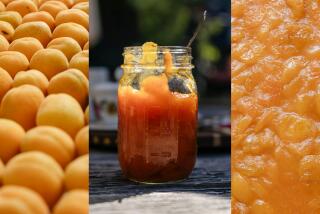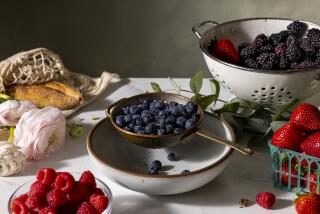IN THE KITCHEN : I Jam, I Said
- Share via
If strawberry jam is the essence of sweetness and innocence, why does it cause so much trouble in the kitchen?
Strawberries are high in water and low in pectin and acid. As any jam and jelly maker will tell you, that spells trouble with a capital T, which in this case stands for “thin.” In fact, most jelly makers add pectin to strawberry jam to make it thicker. But when you add pectin, you have to add more sugar, and then all that sweetness clouds a strawberry’s sunny taste.
Over the years, I’ve investigated different methods of making strawberry jam--everything from the almost-instant quick-boiling technique to the comparatively glacial “sun preserves” (you set the berries outside, uncovered, and let the sun evaporate the liquid). The first method consistently failed to jell, yielding a pretty tasty syrup. The latter I didn’t even attempt. Maybe if I lived someplace with no bugs . . .
This year, I tried a new way, and I think it works the best so far. An adaptation of a recipe from Helen Witty’s “Fancy Pantry”--a great guide for those starting to can and pickle--it’s kind of a combination of the quick-boil and sun-dried methods.
*
Strawberries and sugar are macerated overnight, then brought to a quick boil and poured into a large, shallow pan where they cool quickly and set out (unrefrigerated but indoors) for several days. Finally, the strawberry juice is drained into a preserving pan and cooked to the jellying point (between 220 and 225 degrees). The strawberries are added to the syrup, then the lot is brought back to a boil. Finally, it is canned.
It sounds like a lot of trouble, but you do it over several days. Believe me, after five batches this spring, the family got used to having trays of cooling berries sitting around the kitchen.
It’s an interesting process. First, unless you have tried it, you can’t imagine how much liquid a strawberry gives off when macerated with sugar. After 12 hours from a completely dry start, a half flat of strawberries mixed with five cups of sugar will swim in liquid--roughly 6 1/2 cups--while the berries have reduced to only six cups.
To be honest, I can’t figure the purpose of the next step, the initial boiling, except that perhaps the fruit breaks down more to allow better penetration of the sugar (sugar, of course, is quite literally what preserves jams and jellies, preventing molds from forming).
Something certainly happens. In the cooling and rest period that follow, the mass of the jam reduces by about one-third--the result of a combination of evaporation and the fruit reabsorbing the liquid it earlier gave off. In one test run, the amount of liquid reduced from 6 1/2 cups to 4. Curiously, the solids reduced as well, by almost an identical amount--from 6 cups to 4.
*
Though it may not seem so, leaving the fruit at room temperature is safe--the presence of so much sugar discourages anything from growing. Besides, anything that does grow will surely be killed as the jam is later heated to between 220 degrees and 225 degrees.
The heating process, which calls for a balancing of several factors, is the most complicated part of making the jam. First, you want to cook the jelly as quickly as possible, to keep the taste as fresh as you can. But if the heat is too high, the jelly scorches. At the same time, the jellying point for this sugar syrup should be 220 degrees (at sea level, anyway; at higher altitudes, add eight degrees to the boiling point of water). If it fails to reach that temperature, the jelly surely won’t hold and you’ll be left with a very syrupy jam. But if you cook it too far past that temperature, the jelly will be tough and the flavor, of course, will be even more cooked.
You can see the physical changes in the sugar solution as it progresses from liquid to syrup to jelly. At first, the sugar syrup bubbles thinly like boiling water, though, thanks to the sugar, at a much lower temperature--roughly 180 degrees. After a couple of minutes, as the temperature climbs to 200 degrees, the frothy bubbles start to build structure, more than doubling in volume and taking on an almost plastic appearance. (It is at this point that you must be diligent in watching for boil-overs. You don’t know sticky until you’ve cleaned up baked-on, boiled-over jelly.)
This plasticity increases until the foam looks almost like marshmallows, though the volume subsides as the temperature approaches 210 degrees. The hotter the syrup gets, the smaller the bubbles become. At 215 degrees, the syrup is thick enough to coat the holes in a slotted spoon. At 217 degrees, the syrup suddenly smells a little burnt and deep stirring shows a bit of scorch on the tip of the spoon, so I take the pot off the heat to cool. Before putting it back on, I reduce the heat to medium-low and begin stirring constantly to keep it from scorching further.
*
By 220 degrees--which, if the thermometer is accurate, should be the jellying point--the syrup starts to bubble more, in big bubbles that seem to push through the foam from the bottom. The syrup turns darker. When I tilt the pan from side to side, I can see the bottom cleanly as the big bubbles come through the thick foam.
To make sure the temperature is sufficient, I push it a little further, then add the strawberries all at once. There is much hissing, the foam goes completely away and I stir madly to keep it from scorching more. I return the heat to high and just barely bring the berries to the boil.
From the 12 1/2 cups I started with, the jam has reduced to 6 1/2 cups--liquids and solids combined. (In this test batch, it turns out, the jam cooked a bit too long. There is a hint of scorch in the taste, but most importantly, the flavor is not as fresh as it would be if it had cooked less.)
Some people think canning requires a lot of fancy equipment but, in truth (as in any kind of cooking), special equipment only makes the job easier--it doesn’t necessarily make the finished product any better. Still, at times I would give anything for a good canning funnel and jar lifter.
*
As it is, at my house I make do with a couple of battered spaghetti pots--one wider than it is tall, with non-stick coating; the other taller than it is wide, and with a steamer insert. While the jam cooks in the first (the non-stick finish is very handy for clean-up), the second is filled with water, then heated to a boil.
After the jam has finished cooking, I ladle it into sterilized jars while the jam is still hot, wipe the rims clean, fasten the lids and carefully lower the jars into the boiling water (when all the jars are in the pot, the water must cover the tops). I let it boil for 20 minutes, then use the steamer insert to remove the jars all at once. The jars are wiped clean (inevitably, you’ll spill some strawberry schmutz on the outside when you’re ladling them full) and set aside to cool. The next morning, I press each jar lid. If one pops back up, the boiling procedure needs to be repeated (in my five batches this spring, this has yet to happen).
Does this method make the perfect strawberry jam? I won’t go that far, but it’s the best I’ve yet made. The taste is usually fresh and bright, and it has hit a really nice jell four tries out of five. From my experience, that’s a pretty good percentage when working with something as devilish as strawberries. And the way I figure it, all I have to do with the flop is make up labels for “Strawberry Sauce” instead of “Strawberry Jam.”
*
The quality of the fruit is extremely important in making any kind of preserve. Carefully cull the strawberries, removing any bruises and soft spots. You want berries that are ripe, but it is better that they be slightly underripe than over--the pectin is higher in the former. While I prefer the Chandler variety of strawberries for eating raw, I find the Seascape variety works better in jam--it’s drier and less sweet, and I think it gives a slightly spicier preserve.
STRAWBERRY JAM
1/2 flat strawberries (6 pints)
5 cups sugar
Juice 1/2 lemon
Rinse, drain and hull strawberries. Cut each strawberry in half. Layer strawberries in large mixing bowl with sugar. Mix well and let set overnight.
Next day, bring strawberry mixture to boil and cook 3 to 4 minutes. Remove from heat, stir in lemon juice and pour into large, flat container. Let cool in container. Let stand, unrefrigerated, at least 3 days.
To make preserves, prepare large canning kettle full of boiling water and 6 clean, scalded 8-ounce jelly jars and lids.
Drain liquid from strawberries and bring liquid to boil over medium-high heat. Watch carefully or it will boil over. Maintain at full boil until candy thermometer reaches 220 degrees. Add reserved strawberries, stir in thoroughly, reduce heat to medium and boil, stirring constantly, until berries come back to full boil, about 10 minutes.
Remove from heat and ladle hot mixture into jars. With clean, damp cloth, wipe rims of jars. Attach lids and screw tight. Put jars in boiling water in canning kettle and boil 20 minutes. Remove from water, wipe clean and leave to cool. When cool, check lids. Lids should not spring back when pressed down. Store in cool, dry place until opened, then in refrigerator. Makes 6 (8-ounce) jars.
Each 1-tablespoon serving contains about:
46 calories; trace sodium; trace cholesterol; trace fat; 12 grams carbohydrates; trace protein; 0.11 gram fiber.
More to Read
Eat your way across L.A.
Get our weekly Tasting Notes newsletter for reviews, news and more.
You may occasionally receive promotional content from the Los Angeles Times.







